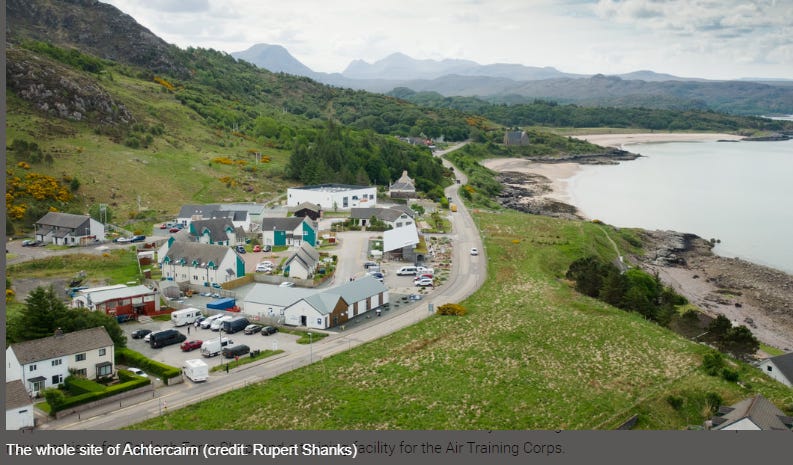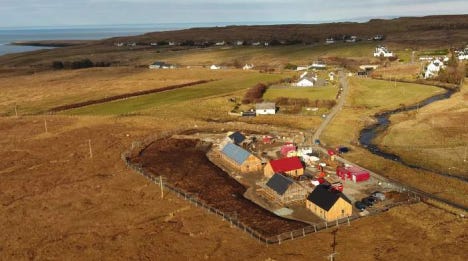Applying the 15-minute city concept in rural areas - does it make any sense?
The Scottish Government has recently announced a public consultation on the inclusion of ‘the 20-minute neighborhood’ concept within the latest version of its National Planning Framework, which provides guidance to local authorities for the future development in their areas. It is part of the Scottish Government’s drive to promote ‘living locally’ as a means of building sustainable and resilient communities and helping to achieve zero-carbon targets.
It is interesting that the 20-minuten neighborhood is to be contained in national planning guidance, and in a country as diverse in the character of its settlements as Scotland. Whilst the 15-minute city concept has been gaining traction in cities in many parts of the world (including Edinburgh), as the name implies it is usually associated with urban areas and city neighborhoods. But much of Scotland is rural or remote with small towns and communities widely scattered across rural and sometimes rugged mainland and island areas.
The Scottish National Planning Framework document expects that the 20-minute neighborhood principles may be adjusted to varying geographical scales from cities to urban environments to rural and island communities. But is it too much of a stretch of the 20-minute neighborhood idea for it to be meaningful across these rural and remote areas? Or can the essence of the concept serve a useful purpose to guide planning in these sometimes-fragile places? What are the issues such applications raise for future planning? These ae my concerns in this essay.
Living locally
The underlying objective of 15-minute city model (or it’s 20-minute neighborhood variant) is to encourage and support communities to access their daily goods and services locally, by sustainable means. The model seeks to create networks of well-connected ‘complete’ neighborhoods to sustain richer local living and reduce travel time and car use through its stress on active travel. It is seen as a useful approach to re-enforcing a local focus in planning policy and place-based decision making. It is an adaptable approach which can evolve to suit the characteristics of differing neighborhoods in ways which it is claimed are beneficial to local economies, community cohesion and local health and wellbeing whilst also having benefits to the local environment and attempts to reach zero-carbon targets. I have discussed the narratives underlying the concept in an earlier paper., but mainly In an urban context (1).
Rural areas
By their very nature, rural scattered communities must already ‘live local’ in aspects of their day-to-day activities. The 15-minute city ideal of the ‘complete neighborhood’ becomes problematic in a rural context, but there is nevertheless a strong desire in government policy in Scotland and elsewhere to support rural economies and extend opportunity for participation in wider society on an inclusive basis.
The sparsely populated rural communities often lack services and transport links which are seen as not viable in such areas, necessitating travel to district centres to access services. Living well locally depends on getting services to communities rather than people to services. Sustainable rural communities share with urban neighborhoods in requiring access to affordable housing, retail outlets, opportunities for year-round employment, cultural facilities and digital connectivity.
Planners and other stakeholders are looking at a range of approaches to meeting these pressures on rural areas and the effective delivery of accessible quality public services in these areas.. At the very least, the 15-minute city model requires a focus on a local place-based approach, and re-enforces the need for holistic joint and collaborative working between planners, service providers and the local communities themselves.
Two Scottish examples
Gairloch, Wester Ross
Gairloch is a community on the west coast of Scotland which can be seen as an excellent example of what amounts to an application of the 20-minute neighborhood concept in a rural location, although it was not labelled as such when development plans were being formulated. The Achtercairn development has transformed a previously derelict area in the centre of the community to provide 25 new homes managed by a council housing society. The project also includes a community centre run by a local social enterprise which includes a community shop and café, selling produce from over 40 local producers and supporting a wider circular economy, and growing and compost space to support zero waste and low food miles. Also included was a new classroom for the University of the Highlands and Islands, new premises for Gairloch farm shop and a training facility for the Air Training Corps. The development is located close to an existing primary and secondary education complex. There is also within the community a bank and community health services.

Stafin
Stafin is a small crofting community of around 600 people on the Isle of Skye. It is a working community and with many seasonal visitors and tourists. However Stafin, in common with many other places in remote areas has a lack of all-year round employment, lack of affordable housing and an ageing and falling population as young people leave for work elsewhere. The Stafin Community Trust in partnership with other agencies has undertaken a mixed development of 6 affordable homes and two commercial units providing workshop space for local businesses, and a new health centre.

Both of these examples of imaginative rural community development show that it is possible to create communities with some features which are prominent within the 15-minute neighborhood concept such as affordable housing, local employment opportunities and improved community health services. It nevertheless prompts questions about what the utility of the concept might be, and in particular the added value it may bring to well established rural development practice.
Relevance
The report from a practitioner roundtable in 2022 (2) organized by several organizations concerned with promoting support for rural communities in Scotland (Scottish Rural Action, Scotland’s Regeneration Forum and the Scottish Rural and Islands transport Community) provides a valuable community-based perspective on these questions.
It is clear that some of the prominent aspects of 15-minute neighborhoods in urban settings are irrelevant to rural and remote settings. In particular, the issue of creating sufficient population density thought necessary in an urban setting to ensure a 20-minute neighborhood is economically viable and able to sustain a wide range of public services and cultural facilities is totally unrealistic by the very nature of rural communities. Secondly, the definition of a neighborhood or community by travel time is also meaningless in the rural context. Sparsity means those accessing community-based services may define community by distance rather than by travel time. Related to this is a third aspect of the 15-minute neighborhood concept in its stress on walkability and active travel. Clearly distance and terrain are limiting factors in the feasibility of these modes of travel in rural and remote areas where car-related travel remains critical for rural and island areas.
But if these aspects of the ideal type 15-minute neighborhood are irrelevant to rural areas, others were seen as more helpful. First, the stress on decentralized and readily accessible localized community services was directly pertinent to debates about the appropriate forms of public service provision in rural areas, and to counter tendencies to the centralization of public services by regional or district authorities. Secondly, the emphasis on connectivity between neighborhoods through affordable public transport and active travel networks highlights the need for innovation in rural mobility that increases accessibility whilst encouraging reduction in car usage. Thirdly the emphasis on digital connectivity for accessing services, promoting employment opportunities and homeworking, and access to widening educational and leisure activities was of special relevance to rural areas.
Added value
Scotland is the only country in the world that wishes to apply the 20-minute neighborhood concept on a national scale. To do so obviously requires a flexible concept of what constitutes a 20-minute neighborhood if it is to be a feature of such a diverse range of communities as are evident across the country.
The 20-minute neighborhood in the context of rural and remote areas is as much a method of approach to rural planning as it is a specific outcome. However there is a serious risk that an attempt is made to shoehorn community planning into this framework when good practice in community planning and development is already evident in many places. Even when the 20-minute (or 800 metre) guideline travelling time is set aside along with other irrelevant aspects discussed above, it is as a method to remind planners of the vital importance of community-led planning, based in an easily visualized view of the built and natural environment communities wish to live in, that its value lies. The emphasis on finding innovative ways to bring the elements of living well locally to communities in order to minimize the extent to which people need to travel to access such facilities elsewhere is welcome, but is leading to outcomes for communities which is already being achieved in some places at least from existing good practice. The extent that the concept encourages such developments in more locations is a measure of its value added to rural community development across the country.
References
1 Changing the Rhythm of Life? The 15-minute city and urban planning online at Changing the Rhythm of Life? The 15-minute City and Urban Planning (substack.com)
2 20 minute neighborhoods in rural and Island Scotland – Report from a practitioner round-table 2022 online at 20 MN in Rural & Island Scotland - Report from Practitioner Roundtable - January 2022.pdf (sra.scot)
 Printer-friendly version
Printer-friendly version- Login to post comments







